Ford Explorer
The Ford Explorer is a range of SUVs manufactured by Ford Motor Company since the 1991 model year. The first four-door SUV produced by Ford, the Explorer was introduced as a replacement for the two-door Bronco II. Deriving its name from a trim package used on the F-Series pickup trucks (as with the Ranger), the Explorer is slotted between the Edge CUV and standard-wheelbase Expedition.
| Ford Explorer | |
|---|---|
 1995–98 Explorer | |
| Overview | |
| Manufacturer | Ford Motor Company |
| Production | 1990–present |
| Model years | 1991–present |
| Body and chassis | |
| Class | Compact SUV (1991-2001)[1] Mid-size SUV (2002–2010)[2] Mid-size crossover SUV (2011–present)[3][4] |
| Layout | Front engine, rear-wheel drive (except fifth generation) Front engine, front-wheel drive (fifth generation only) Front engine, four-wheel drive (optional all generations) |
| Chronology | |
| Predecessor | Ford Bronco II |
| Successor | Ford Bronco (for Explorer mid-size SUV) Ford Territory (in Oceania) |
Currently in its sixth generation, the Explorer has been offered with a number of chassis and powertrain layouts through its production. The first two generations were directly derived from the Ford Ranger, switching to a model-specific chassis for two generations. The fifth-generation adapted a variant of Ford Taurus chassis architecture (developed for SUV use), with the current generation again reverting to a model-specific chassis. Alongside the five-door Explorer wagon, a three-door wagon was offered from 1991 to 2003 (effectively succeeding the Bronco II).
Through its 29-year production run, variants of the Explorer have been sold by Mercury, Lincoln, and Mazda; Lincoln currently markets the model line as the Lincoln Aviator. For police use, Ford has developed the Ford Police Interceptor Utility, serving as a replacement for the (replacing the Ford Crown Victoria Police Interceptor and the Taurus-based Police Interceptor Sedan).
The first four generations of the Explorer were produced by Ford at its Louisville Assembly Plant (Louisville, Kentucky) and at its now-closed St. Louis Assembly Plant (Hazelwood, Missouri); the model line is now currently produced at Chicago Assembly (Chicago, Illinois).
First generation (1991–1994)
| First generation (UN46) | |
|---|---|
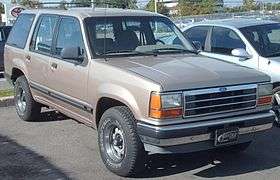 First-generation Ford Explorer | |
| Overview | |
| Also called | Mazda Navajo |
| Production | February 15, 1990[5] – November 1994[6][7] |
| Model years | 1991–1994 |
| Assembly | Louisville, Kentucky, United States (Louisville Assembly Plant) St. Louis, Missouri, United States (St. Louis Assembly) Valencia, Venezuela (Valencia Assembly) |
| Body and chassis | |
| Body style | 3-door SUV 5-door SUV |
| Layout | Front engine, rear-wheel drive / four-wheel drive |
| Related | Ford Ranger |
| Powertrain | |
| Engine | 4.0 L OHV Cologne V6 |
| Transmission | 5-speed M5OD-R1 manual 4-speed A4LD automatic |
| Dimensions | |
| Wheelbase | 3-door: 102.1 in (2,593 mm) 5-door: 111.9 in (2,842 mm) |
| Length | 3-door: 174.5 in (4,432 mm) 5-door: 184.3 in (4,681 mm) |
| Width | 70.2 in (1,783 mm) |
| Height | 3-door: 67.5 in (1,714 mm) 5-door: 67.3 in (1,709 mm) Eddie Bauer: 68.3 in (1,735 mm) |
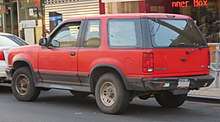
.jpg)

The Ford Explorer was introduced in March 1990 for the 1991 model year. To better compete against the Chevrolet S-10 Blazer and Jeep Cherokee mid-size sport-utility vehicles, Ford sought to replace the Bronco II with a vehicle sized closer to its competitors. In an effort to attract family buyers, a four-door version was developed alongside the two-door (launched the same month as the four-door S-10 Blazer). The Explorer was longer and wider than the compact Bronco II, placing it in a higher size class.[8]
As with the Bronco II, the first-generation Explorer shares its chassis and underpinnings with the first-generation (1983-1992) Ford Ranger. However, in comparison to the Bronco II, the Explorer is far larger, with the two-door Explorer Sport gaining 12.6 inches in length and 2.2 inches of width; a four-door is 22.4 in (569 mm) longer[8] and 730 lb (331 kg) heavier.
Commonality with the Ranger extends to the exterior, with the Explorer sharing its front bumper, fenders (modified), headlights, grille, and wheels; with the exception of its steering wheel hub, the Explorer shares its entire dashboard with the Ranger. In a major change from the Bronco II, the Explorer was given its own front door stampings. In addition, the additional width allowed for two major aerodynamic improvements; along with the elimination of exterior drip rails (by wrapping the doors into the roof), the sideview mirrors were integrated onto the doors (rather than bolted on).
Chassis
Sharing its engine with the Ranger and four-wheel drive Ford Aerostar, the Explorer was fitted with a German-produced 155 hp (116 kW) 4.0 L Cologne V6 as the sole engine offering, replacing the previous 2.9 L V6. A Mazda M5OD 5-speed manual was the standard transmission offering, with the option of the Ford 4-speed A4LD overdrive automatic transmission. For 1993, the engine output was increased to 160 hp (119 kW).
Along with the standard rear-wheel drive powertrain, at its launch, the Explorer was also offered with various configurations of part-time four-wheel drive, powered by a Borg Warner 13–54 transfer case. In addition to a manually shifted transfer case, Ford offered "Touch Drive" electronic push-button shifting; both were "shift-on-the-fly" designs that allowed the vehicle to be shifted from two-wheel drive to "four-high" at any speed and into "four-low" when the vehicle was stopped. All Explorers were equipped with the Ford 8.8 axle in either a limited slip differential, or open version with a variety of available gear ratios. Four-wheel-drive front axles were the TTB ("Twin Traction Beam") Dana 35 with some Dana 44-spec components.
Trim
At its launch, the Ford Explorer followed the Aerostar, Bronco, Econoline, F-Series, and Ranger in model trim. The XL was sold as the base trim, with XLT as the upper range, with the outdoors-themed Eddie Bauer trim as the top trim. The XL was distinguished by a black grille (chrome optional) with steel wheels, while the XLT offered a chrome grille and alloy wheels; the Eddie Bauer offered alloy wheels and two-tone paintwork.
The Ford Explorer Sport was offered solely on the two-door body style. Offering black lower bodywork and grille and alloy wheels, the Sport was intended as a replacement for the Bronco II. From 1990 to 1994,[9] Mazda marketed the two-door Ford Explorer as the Mazda Navajo; the model was awarded the 1991 Motor Trend Truck of the Year award. [10]
The Ford Explorer Limited was introduced for 1993 as a luxury-trim model slotted above the Eddie Bauer. Largely introduced as a competitor to the Oldsmobile Bravada, the Explorer Limited was offered only as a four-door with an automatic transmission. Distinguished by its color-matched grille, headlight trim, and model-specific bodywork and wheels, the Limited was offered with several model-specific features, including automatic headlights, an auto-dimming rearview mirror, foglamps, and center roof console (with compass and outside thermometer).
Second generation (1995–2001)
| Second generation (UN105/UN150) | |
|---|---|
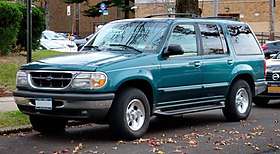 | |
| Overview | |
| Also called | Ford Explorer Sport (3-door) |
| Production | November 1994 – December 2000[11] November 1994–July 2003 for Sport |
| Model years | 1995–2001 (5-door) 1995–2003 (3-door) |
| Assembly | Louisville, Kentucky, United States (Louisville Assembly Plant) St. Louis, Missouri, United States Valencia, Venezuela (Valencia Assembly) |
| Designer | Bob Aikins (1992) |
| Body and chassis | |
| Body style | 3-door SUV (1995–2003) 5-door SUV (1995–2001) |
| Layout | Front engine, rear-wheel drive / four-wheel drive |
| Related | Ford Explorer Sport Trac Mercury Mountaineer |
| Powertrain | |
| Engine | 4.0 L Cologne OHV V6 (1995–2000) 4.0 L Cologne SOHC V6 (1997–2003) 5.0 L small block OHV V8 (1996–2001) |
| Transmission | 5-speed M5OD-R1 manual (4.0 L OHV) 5-speed M5OD-R1HD (2001–2003 Explorer Sport) 4-speed 4R55E automatic (4.0 L 1995–1996) 4-speed 4R70W automatic (V-8 models) 5-speed 5R55E automatic (4.0 L 1997–2001) |
| Dimensions | |
| Wheelbase | 1995–97 5-door: 111.5 in (2,832 mm) 1998–2001 5-door: 111.6 in (2,835 mm) 1995–99 3-door: 101.7 in (2,583 mm) 2000–03 3-door: 101.8 in (2,586 mm) |
| Length | 1995–2001 5-door: 190.7 in (4,844 mm) 1995–97 3-door: 178.6 in (4,536 mm) 1998–99 3-door: 180.8 in (4,592 mm) 2000–03 3-door: 180.4 in (4,582 mm) |
| Width | 70.2 in (1,783 mm) |
| Height | 67.0–68.3 in (1,702–1,735 mm) |
_(cropped).jpg)
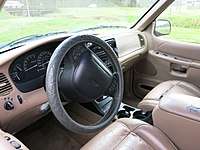
The second-generation Ford Explorer made its debut in late 1994 as a 1995 model. Retaining the same footprint as its predecessor, the 1995 Ford Explorer underwent extensive modifications to its chassis to improve its road manners. In an effort to better differentiate the model line from the Ford Ranger, Ford stylists redesigned the vehicle, giving the Explorer a model-specific exterior. As with its predecessor, the second generation was sold in both three-door and five-door configurations. Rear-wheel drive was standard, with four-wheel drive offered as an option.
Following the January 2001 introduction of the third-generation five-door Ford Explorer, the three-door Explorer Sport became a stand-alone model on the second-generation design; the Explorer Sport was produced through the 2003 model year.
This generation of the Ford Explorer marks the debut of the 1997 Mercury Mountaineer, introduced in 1996 by Mercury. In early 2000, the Ford Explorer Sport Trac was introduced, which was a mid-size pickup truck; offered with a crew cab with a short pickup bed, the Sport Trac was based on the five-door Explorer. The Explorer Sport Trac was produced through the 2005 model year (until it was redesigned for 2007).
Outside of North America, this generation of the Explorer was marketed in right-hand drive configurations As of 2018, RHD countries (such as Japan) export used examples of the Explorer to other countries (such as Australia and New Zealand) where there is demand for right-hand drive SUVs. Due to Japan's strict Shaken Laws, used vehicles tend to have low mileage with detailed repair histories.[12] In the United States, the second-generation Ford Explorer has the (dubious) distinction of being two of the top five vehicles traded in under the 2009 "Cash for Clunkers" program, with the 4WD model topping the list and the 2WD model coming in at number 4.
Chassis
The second-generation Ford Explorer is based upon the Ford U1 platform shared with its predecessor, adopting the UN105/UN150 model codes. Alongside similar changes in development for the 1998 Ford Ranger, the long-running Twin I-Beam/Twin Traction Beam front suspension was retired in favor of a short/long-arm (SLA) wishbone front suspension configuration. Along with more compact packaging of front suspension components, the design allowed for improved on-road handling/feel.
Powertrain
The optional engine of the Ford Ranger and Ford Aerostar, the 160 hp 4.0 L OHV V6 was carried over from the first-generation Ford Explorer. To match the V8 engine of the similar-sized Jeep Grand Cherokee, for the 1996 model year, Ford introduced a 5.0 L V8 as an option. Initially available on rear-wheel drive XLT models, the availability of the 210 hp (157 kW) V8 was expanded to many versions of the five-door Explorer, and came standard with all-wheel-drive starting in 1997. For 1997, revised cylinder heads increased output of the 5.0 L V8 to 215 hp (160 kW). Following the January 1996 introduction of the 4.6 L SOHC V8 by the Ford F-Series and E-Series, the Explorer would be the last vehicle in North America by Ford Motor Company sold with the company's old-style gasoline pushrod V8 for over 20 years (a new pushrod V8 was introduced for MY 2020 in the Ford Super Duty trucks).
For 1997, the Ford Explorer gained a third engine, as Ford introduced an overhead-cam version of the 4.0 L Cologne V6. Using a common displacement with the pushrod 4.0 L V6, the 210 hp (157 kW) SOHC V6 rivaled the V8 in engine output. Offered as standard equipment on the top-trim Eddie Bauer and Limited trims, the engine became an option on all other versions of the Explorer and Explorer Sport. For 2001, the pushrod V6 was discontinued, with the SOHC becoming the standard engine in all versions of the Explorer (and the sole engine of the 3-door Explorer Sport).
For 2000, Ford added flex-fuel capability to the Explorer for the first time.
| Engine | Production | Configuration | Power | Torque | Transmission | Transfer Case |
|---|---|---|---|---|---|---|
| Ford Cologne V6 | 1995-2000 | 245 cu in (4.0 L) OHV 12V V6 | 160 hp (119 kW) | 220 lb⋅ft (298 N⋅m) | 5-speed manual (Mazda M5OD-R1)
4-speed automatic (Ford 4R55E); 1995-1996 5-speed automatic (Ford 5R55E); 1997-2000 |
Borg Warner 44-05 Electric Shift Control Trac |
| Ford Cologne V6 | 1997-2003 | 245 cu in (4.0 L) SOHC 12V V6 | 210 hp (157 kW) | 254 lb⋅ft (344 N⋅m) | 5-speed manual (Mazda M5OD-R1HD); 2001-2003 Explorer Sport
5-speed automatic (Ford 5R55E) |
Borg Warner 44-05 Electric Shift Control Trac; 1997-2001
Borg Warner 13-54 Electric Shift; 2001-2003 Explorer Sport |
| Ford small block 5.0 L V8 | 1996-2001 | 302 cu in (4.9 L) OHV 16V V8 | 210 hp (157 kW) | 280 lb⋅ft (380 N⋅m) | 4-speed automatic (Ford 4R70W) | Borg Warner 44-04 Full-Time AWD |
A Mazda-produced 5-speed manual was standard with OHV V6 engine. The SOHC did not receive the 5-speed until 2000, but it was a stronger unit than the one behind the OHV. All V8 examples were equipped with a 4-speed heavy-duty automatic (shared with the F-150, Mustang, and Crown Victoria).
The four-wheel drive system was redesigned for the 1995 Explorer. For the V6 models, in place of Touch Drive from the previous generation, ControlTrac was an electronically controlled full-time four-wheel drive system with a two-speed transfer case, with software controlling a multi-disc clutch (in place of a center differential). Along with traditional two-wheel drive and high and low-range four-wheel drive, "Auto" mode allowed software to maintain the amount of torque sent to the front wheels; if the front axle begins to spin slower, torque is shifted from the rear wheels to the front wheels until traction is achieved. Similar to TouchDrive, ControlTrac is dash-controlled, with a rotary selector for two-wheel drive (1995-1996, 2001-2003 Sports), auto (1997-2001), high range, and low range.
The V8 models came equipped with a different full-time AWD system, without the 4x4 High-Range/Low-Range feature. The system required no driver input and torque distribution was entirely managed by a viscous clutch with a 40/60 split.
Body

.jpg)
While visibly similar to its predecessor, many exterior panels from the 1995 Ford Explorer were changed, with only the roofline and the side doors carrying over. As part of the changes related to the redesigned front suspension, the entire front fascia was redesigned, with the Explorer gaining model-distinct styling. In a styling theme that would be used in several other Ford small trucks, the 1995 Explorer was given an oval grille; the headlamps were changed from rectangular to oval as well, wrapping into the fenders. Depending on trim, the grille and bumpers were painted gray (XLT), body color (Limited/Sport), or chromed. In contrast to the front fascia, the rear fascia saw relatively few changes, with the rear bumper nearly unchanged. Along with slightly reshaped taillamps (with amber turn signals), the 1995 Ford Explorer marked the debut of a neon CHMSL (center brake light).[13]
Alongside the redesigned exterior, the interior of the second-generation Ford Explorer was given a redesign. Maintaining commonality with the Ranger, the Explorer was given a new dashboard (marking the debut of dual airbags in an American-produced SUV), a new instrument panel; to improve user ergonomics, the Ford Explorer introduced a double-DIN radio panel and rotary-style climate controls.
For 1997, a third-row seat was introduced as an option; expanding seating to seven passengers, the design was only offered in export markets.
For 1998, the exterior of the Ford Explorer was given a mid-cycle update. Distinguished by the addition of fender flares, the rear fascia was restyled, with larger taillamps; to better accommodate export, the license plate was shifted from the bumper to the liftgate; the neon CHMSL was replaced by an LED version. 16-inch wheels replaced 15-inch wheels (shared with the Ranger). For 1999, the front bumper was redesigned, allowing for larger lower grille and fog lights.
The interior was given redesigned front and rear seats, along with second-generation airbags; side airbags were introduced (as an option). Other options included load-leveling air suspension (on Eddie Bauer and Limited) and a reverse-sensing warning system.
Trim
At its launch, the second-generation Ford Explorer retained the use of the previous trim nomenclature; the standard trim was the XL, with the XLT serving as the primary model upgrade. Along with the two-tone Eddie Bauer trim, the highest trim Explorer was the monochromatic Ford Explorer Limited. For 2000, XLS replaced XL as the base trim (introduced as an appearance package for 1999).
In contrast to five-door Explorers, second-generation three-door Ford Explorers shifted to a separate trim nomenclature. While the XL remained the base model (largely for fleets), most examples were produced under a single Sport trim level. In 1995, the Expedition trim was introduced; roughly the 3-door equivalent of the Eddie Bauer, the trim was discontinued at the end of the model year as Ford reserved the name for the Ford Expedition full-size SUV (which entered production in mid-1996).
For 1998, the Explorer Sport became the sole version of the three-door; following the introduction of the third-generation Explorer, the Explorer Sport became a distinct model through the 2003 model year.
Third generation (U152; 2002–2005)
| Third generation (U152) | |
|---|---|
 | |
| Overview | |
| Production | November 2000–June 2005 |
| Model years | 2002–2005 |
| Assembly | Louisville, Kentucky, United States St. Louis, Missouri, United States Valencia, Carabobo, Venezuela |
| Designer | Edward Golden (1997)[14] |
| Body and chassis | |
| Body style | 4-door SUV |
| Layout | Front engine, rear-wheel drive / four-wheel drive / all-wheel drive |
| Related | Ford Explorer Sport Ford Explorer Sport Trac Lincoln Aviator Mercury Mountaineer |
| Powertrain | |
| Engine | 4.0 L Cologne V6 4.6 L 16-valve Modular V8 |
| Transmission | 5-speed M5OD-R1HD manual 5-speed 5R55W automatic 5-speed 5R55S automatic |
| Dimensions | |
| Wheelbase | 2002–03: 113.7 in (2,888 mm) 2004–05: 113.8 in (2,891 mm) |
| Length | 189.5 in (4,813 mm) |
| Width | 72.1 in (1,831 mm) |
| Height | 71.4 in (1,814 mm) |
The third-generation Ford Explorer went on sale in January 2001 (as an early 2002 model). The U152 program began in 1995, with the final design being chosen in 1997 and frozen for production in February 1998, with development ending in 2000. The primary objective behind the third-generation Ford Explorer was to make the vehicle line more competitive in both domestic and export markets.[15] Along with tuning the Explorer for higher-speed European driving, the Explorer was benchmarked to lead against the Lexus RX300 and the then-in-development Volkswagen Touareg.[15]
_XLT_wagon_(2015-06-25)_02.jpg)
To make the Explorer more competitive, Ford shifted away from typical SUV design, abandoning the use of the Ford Ranger chassis architecture in favor of designing a purpose-built platform. As part of the change, the Explorer became only the second rear-wheel drive American Ford platform fitted with four-wheel independent suspension (behind the MN12 platform). In another major change, the third-generation Explorer was developed solely as a five-door vehicle. Retaining the previous-generation chassis architecture, the three-door Explorer Sport continued production through the 2003 model year; the Explorer Sport Trac four-door pickup truck continued through 2005.
The third-generation Ford Explorer was marketed by all three divisions of Ford Motor Company: by Mercury as the second-generation Mercury Mountaineer; Lincoln marketed the third-generation Explorer from 2002 to 2005 as the Lincoln Aviator.
Chassis
The third-generation is based on the body-on-frame Ford UN152 platform. No longer derived from the Ford Ranger, the UN152 chassis was designed specifically for the five-door Explorer and its Lincoln-Mercury counterparts. In a major shift from its predecessors, the third-generation Explorer adopted a four-wheel independent suspension configuration, never before used on a Ford truck (on American-produced SUVs, fully independent suspension was previously exclusive to the Hummer H1). Similar to the layout used on the Ford MN12-chassis cars (1989-1998 Thunderbird/Cougar and Lincoln Mark VIII), each rear wheel was connected to the rear-axle differential with two half-shafts.
While the third-generation Ford Explorer was in development during the late 1990s a controversy involving the Explorer and Firestone tires developed, thus the increased stability of the configuration was designed in part to reduce rollover risk.[16][17] In another change, Firestone tires (which had caused the rollovers and crashes of the Ford Explorers) were not made available on any version of the third-generation Explorer. Ford's AdvanceTrac RSC (Roll Stability Control) system became available as a standard feature on the Explorer for the 2005 model year.
Along with rear-wheel drive, the third-generation Explorer was offered with both four-wheel drive and permanent all-wheel drive; the latter was offered on the Explorer for the first time.
Carried over from the previous generation, the base engine for the third-generation Explorer was a 210 hp (157 kW) 4.0 L SOHC V6. Becoming the final V8-powered American Ford to adopt to the Modular V8, the third-generation Explorer offered a 239 hp (178 kW) 4.6 L SOHC V8 (shared with the Crown Victoria/Grand Marquis) as its optional engine. A five-speed manual transmission was offered for 2002 before its discontinuation; as of the 2020 model year, it is the final year a Ford Explorer was available with a manual transmission. As an option for both the 4.0L and 4.6L V8 engines, the Ford 5R55 transmission was offered, becoming standard from 2003 to 2005.
| Engine | Production | Configuration | Power | Torque | Transmission |
|---|---|---|---|---|---|
| Ford Cologne V6 | 2002-2005 | 245 cu in (4.0 L) SOHC 12V V6 | 210 hp (157 kW) | 254 lb⋅ft (344 N⋅m) | Mazda M5OD-R1HD 5-speed manual (2002 only)
Ford 5R55 5-speed automatic |
| Ford Modular V8 | 2002-2005 | 281 cu in (4.6 L) SOHC 16V V8 | 239 hp (178 kW) at 4750 rpm | 282 lb⋅ft (382 N⋅m) at 4000 rpm | Ford 5R55 5-speed automatic |
Body
In contrast with the second-generation (a major revision of the 1991-1994 generation), the exterior and interior of the third-generation Ford Explorer were completely new designs. While sharing a number of design elements with the 1997 F-Series and Ford Expedition, the Ford Explorer also served as the introduction of a new design theme for several Ford vehicles; the 2003 Ford Expedition, the Ford Freestar, Ford Freestyle, and Ford Five Hundred would share various elements of the 2002 Ford Explorer design. Retaining nearly the same proportions as the first two generations, the third-generation Explorer was an inch shorter in length and two inches wider, gaining two inches in wheelbase.
With the addition of independent rear suspension, several functional changes were brought as part of the redesign. The cargo floor was lowered several inches, adding nearly 10 cubic feet of total cargo room. Coinciding with the lower cargo floor, on nearly all models, a folding third-row seat was either standard or an option, bringing seating capacity to seven. The rear liftgate was redesigned, with the upper hatch enlarged.
Trim
Ford produced the third generation Explorer in five trim levels: XLS, XLT, NBX, Eddie Bauer, and Limited. Slotted below the XLS were two major trim packages, Sport Value, Sport Choice, with Sport Premium between XLS and XLT. The outdoors-themed Eddie Bauer continued production with a two-tone exterior (with a tan lower body); the Limited wore a monochromatic body. The NBX trim was only made for 2003 and 2004, and was a loaded up XLT with Eddie Bauer-esque features. It was more like a bang-for-your-buck Eddie Bauer model rather than an actual trim level, as it didn't really set itself apart in any way like XLS did from XLT.
Fourth generation (U251; 2006–2010)
| Fourth generation (U251) | |
|---|---|
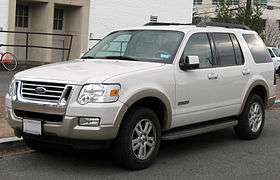 | |
| Overview | |
| Production | July 2005–December 16, 2010[18] |
| Model years | 2006–2010 |
| Assembly | Louisville, Kentucky, United States St. Louis, Missouri, United States Valencia, Carabobo, Venezuela |
| Designer | Jeff Nowak (2003) |
| Body and chassis | |
| Body style | 4-door SUV |
| Layout | Front engine, rear-wheel drive / four-wheel drive |
| Related | Ford Explorer Sport Trac Mercury Mountaineer |
| Powertrain | |
| Engine | 4.0 L Cologne SOHC V6 4.6 L Modular 24-valve V8 |
| Transmission | 5-speed 5R55S automatic 6-speed 6R automatic |
| Dimensions | |
| Wheelbase | 113.7 in (2,888 mm) |
| Length | 193.4 in (4,912 mm) |
| Width | 73.7 in (1,872 mm) |
| Height | 2006–07: 71.2 in (1,808 mm) 2008: 72.8 in (1,849 mm) 2009–10: 71.9 in (1,826 mm) |
| Chronology | |
| Successor | Ford Bronco (2021) |
.jpg)

The Ford Explorer and the Mercury Mountaineer were both updated for the 2006 model year on a new frame, produced by Magna International rather than Tower Automotive. Along with this new, stronger chassis, Ford updated the interior, redesigned the rear suspension and added power-folding third-row seats. Also, a tire pressure monitoring system and electronic stability control became standard equipment. Power running boards, like the ones from the Lincoln Navigator, were also made available on the Explorer and Mountaineer; the running boards lower to allow easier access when entering the vehicle, then retract upon door closure. Unlike previous generations, there was no right-hand drive option available for order, causing Ford to market Explorers in Japan in left-hand drive configuration. The LHD Explorers were desirable there because LHD vehicles are considered prestigious in Japan. Moreover, Ford switched to a one-piece rear liftgate design due to the problems associated with the previous generation's design.
The 210 hp (157 kW) 4.0L 12-valve SOHC V-6 was once again the standard engine. A more powerful 292 hp (218 kW) 4.6L 24-valve SOHC V-8, similar to the Fifth-generation Ford Mustang's engine, was available as an option. The 6-speed 6R automatic transmission, built by Ford and based on a ZF design, was made standard equipment with the V-8 engine as well. The five-speed 5R55W automatic transmission was advanced. It was the only transmission available for the V-6 engine, because the Mazda five-speed manual transmission was dropped in the previous generation.
The 2006 Ford Explorer was nominated for the North American Truck of the Year award for 2006.
Model year changes
For 2007, The Explorer received a few minor updates including standard AUX input on all stereos and optional power running boards, heated windshield, Ironman Package, XLT Appearance Package, and heated leather seat package.
For 2008, Ford added side curtain airbags across the Explorer range. Also, the optional satellite navigation system was also upgraded with voice control.[19]
For 2009, the Explorer received a trailer sway control system as standard equipment, and the navigation system received traffic flow monitoring with updated gas prices from nearby stations.[20]
For the 2010 model year, Ford's MyKey became standard on all Explorers equipped with the Sync system, while V8s were restricted to 4-wheel-drive models.
Engine specifications
| Ford Cologne 4.0 L SOHC V-6 | |
|---|---|
| Model years | 2006–2010 |
| Power (SAE net) | 210 hp (157 kW) |
| Torque (SAE net) | 254 ft⋅lbf (344 N⋅m) |
| Ford Modular 4.6 L SOHC V-8 | |
|---|---|
| Model years | 2006–2010 |
| Power (SAE net) | 292 hp (218 kW) |
| Torque (SAE net) | 315 ft⋅lbf (427 N⋅m) |
Ford Explorer Sport Trac
The second generation Sport Trac came out in early 2006 for the 2007 model year. Unlike its predecessor sold through 2005, it featured the V-8 engine as an option and was based on this generation Explorer's platform. AdvanceTrac with Roll Stability Control was made standard on the Sport Trac.
Sport Trac Adrenalin

For the 2007 model year, the Ford Special Vehicle Team built the Sport Trac Adrenalin concept with a supercharged version of the 4.6 L Modular V-8, with 390 hp (291 kW), and featuring 21-inch (533 mm) wheels. The model was planned by Ford SVT to be the successor to the F-150 Lightning sports pickup truck. However, the SVT version of the Adrenalin was cancelled in a cost-cutting move as part of The Way Forward.[21] The Adrenalin was subsequently sold as an appearance package from 2007-2010. It had blacked-out headlights, black grill, monochrome color interior, unique front and rear bumpers, front fender vents, and molded-in running boards. It also came standard with 20" polished aluminum wheels, and the fender flares that came on the Explorer and standard Sport Trac were deleted.
Explorer America concept

Ford unveiled an Explorer America concept vehicle at the 2008 North American International Auto Show.[22][23][24] The Explorer America concept is built on a unibody platform to reduce weight and improve driveability, migrating from the body-on-frame platform of the fourth generation Explorer. It is designed for up to six passengers while improving fuel economy by 20 to 30 percent relative to the current V6 Explorer. The powertrain packages in the concept vehicle include a two-liter four-cylinder turbocharged direct injection EcoBoost gas engine with 275 hp (205 kW) and 280 ft⋅lbf (380 N⋅m) of torque, and a 3.5L V6 version EcoBoost with 340 hp (254 kW) and up to 340 ft⋅lbf (461 N⋅m) of torque.[25]
Fifth generation (U502; 2011–2019)
| 5th generation (U502) | |
|---|---|
_%E2%80%93_Frontansicht%2C_10._September_2011%2C_D%C3%BCsseldorf.jpg) | |
| Overview | |
| Production | December 1, 2010 – March 3, 2019[26][27] |
| Model years | 2011–2019 |
| Assembly | Chicago, Illinois, U.S. (Chicago Assembly) Valencia, Venezuela (Valencia Assembly) Yelabuga, Tatarstan, Russia[28] |
| Designer | Brian Izard, George Bucher (2008) Mike Arbaugh (facelift: 2013)[29] |
| Body and chassis | |
| Body style | 5-door SUV |
| Layout | Front engine, front-wheel drive / all-wheel drive |
| Platform | Ford D4 platform |
| Related | Ford Flex Lincoln MKT Ford Taurus[30] |
| Powertrain | |
| Engine | 2.0 L EcoBoost turbocharged I4 (front-wheel drive only) 2.3 L EcoBoost turbocharged I4 3.5 L Duratec Ti-VCT V6 3.5 L EcoBoost twin-turbocharged V6 (all-wheel drive only) 3.7 L Cyclone Ti-VCT V6 (Police Interceptor Utility, all-wheel drive only)[31] |
| Transmission | 6-speed Ford 6F automatic w/ overdrive (EcoBoost I4 model) 6-speed 6F SelectShift automatic (3.5L) 6-speed 6F SelectShift automatic with paddle shifters (Sport model)[32] |
| Dimensions | |
| Wheelbase | 112.6 in (2,860 mm)[33] |
| Length | 197.1 in (5,006 mm) |
| Width | 78.9 in (2,004 mm) |
| Height | 70.4 in (1,788 mm) |
| Curb weight | 4,385–4,901 lb (1,989–2,223 kg) |
_%E2%80%93_Heckansicht%2C_10._September_2011%2C_D%C3%BCsseldorf.jpg)
.jpg)
The 5th generation 2011 Explorer bore similarity to the Explorer America concept's construction, and includes a unibody structure based on the D4 platform, a modified version of the D3 platform.[34][35] The move from traditional SUV to crossover effectively vacated the midsize SUV segment for Ford until the sixth generation Bronco arrives, which is scheduled to debuted in July 2020.[36]
The fifth generation Explorer features blacked-out A, B, and D-pillars to produce a floating roof effect similar to Land Rover's floating roof design used on its sport utility vehicles; a design which Ford previously used on the Ford Flex. The fifth generation Explorer features sculpted body work with stepped style headlamps similar to the Flex, Edge, Escape, Expedition and F-150, as well as new stepped style tail lamps. The grille features Ford's corporate three-bar design with upper and lower perforated mesh work, similar to that of the sixth-generation Ford Taurus.
The development of the fifth generation Explorer was led by chief engineer Jim Holland from February 2008 to October 2010, who was also a chief engineer for Land Rover; heading development of the Land Rover Range Rover (L322) 2005 facelift from December 2001 to December 2004. Holland also worked on the Ford Expedition (U324) during its initial development.[37]
The fifth generation Explorer made its debut online on July 26, 2010. Ford had set up a Ford Explorer Facebook page ahead of its debut.[38] Assembly of the fifth-generation Explorer moved to Ford's Chicago Assembly plant commencing December 1, 2010,[39] where it is built alongside the Ford Taurus and Lincoln MKS. The Louisville plant, where the previous generation was built, was converted to produce cars based on Ford's global C platform (potentially including the Ford Focus, Ford C-Max, and Ford Kuga).[40] Like the Escape, the Explorer will continue to be marketed as an "SUV" rather than a "crossover SUV". It went on sale in December 2010, after pre-launch sales had by the end of November 2010 totaled around 15,000.[41] The EPA rated fuel economy of 20/28 mpg city/highway for the four-cylinder EcoBoost engine option.
Features
Available features on the fifth generation Explorer include intelligent access with push button start, remote engine start, power liftgate, power adjustable pedals with memory, premium leather trimmed seating, heated and cooled front seats, dual headrest DVD entertainment system, adaptive cruise control, active park assist, SIRIUS Travel Link, MyFord Touch, Ford SYNC by Microsoft, Sony audio system with HD radio and Apple iTunes tagging, in-dash advanced navigation system, SoundScreen laminated acoustic and solar tinted windshield with rain-sensing wipers, 20-inch polished V-spoke aluminium wheels, and High-intensity discharge headlamps (HID) and LED tail lamps.
Unlike the Explorer America concept vehicle which only seats five occupants, the production Explorer holds two rows of seating with available PowerFold fold flat third row seating (like the previous generation) and accommodates up to seven occupants.[42]
Capability
The Explorer is available in either front-wheel drive or full-time all-wheel drive. At first only one engine was available: the 290 hp (216 kW) (255 lb⋅ft (346 N⋅m) of torque) 3.5 liter TiVCT (Twin independent Variable Camshaft Timing) V-6 attached to either the 6-speed 6F automatic or 6-speed 6F SelectShift automatic.
Soon thereafter, Ford offered the economical 240 hp (179 kW) (270 lb⋅ft (366 N⋅m) of torque) 2 liter EcoBoost turbocharged, direct-injected I-4 mated to the 6-speed 6F automatic. The I-4 engine is not available with the optional 6-speed 6F SelectShift automatic, and will only be available in front-wheel drive.[43][44]
The Explorer is available with an automatic intelligent all-wheel drive system inspired by Land Rover, featuring a variable center multi-disc differential with computer controlled lock.[45] Conventional front and rear differentials are used with 3.39:1 gearing. The center multi-disc differential controls the front-to-rear torque split, biasing as much as 100 percent of torque to either the front or rear wheels.[46] Depending on the Terrain Management mode selected, the center multi-disc differential's intelligent lock will allow for a 50:50 torque split in off-road conditions.[46] The power take off (PTO) unit includes a heavy-duty dedicated cooling system to allow the four-wheel drive system to supply continuous non-stop torque delivery to all four wheels indefinitely, without overheating.[47] A "4WD" badge is advertised on the rear liftgate on the all-wheel drive models.[48][49] Explorer's overall off-road crawl ratio is 15.19:1 with high range – no low range – gearing only.
Off-road electronics include Hill Descent Control (HDC), Hill Ascent Assist (HAA), four-wheel electronic traction control and Terrain Management.
Four-wheel electronic traction control (ABS braking) is employed to simulate front and rear differential locks via aggressively "brake locking" the front or rear differentials, transferring up to 100 percent of torque from side-to-side.[45][47][50] In the right conditions, the Explorer can keep moving even if only one wheel has traction, regardless of which wheel it is.
Terrain Management includes four selectable modes. Each mode is selected via a rotary control dial on the center console, aft of the transmission shifter.
| Terrain Management System[51] | |
|---|---|
| Default start selection: | Normal Driving mode |
| Subsequent modes are selected by turning the control dial clockwise. | |
| Second selection: | Mud & Ruts mode |
| Third selection: | Sand mode |
| Fourth selection: | Grass/Gravel/Snow mode |
Depending on the mode selected, Terrain Management will control, adjust, and fine tune the engine, transmission, center multi-disc differential lock, throttle response, four-wheel electronic traction control and electronic stability control (ESC) to adapt the SUV for optimal performance on the corresponding terrain.
Off-road geometry figures for approach, departure and ramp breakover angles are 21°, 21° and 16° respectively.[33] Minimum running ground clearance is 7.6 inches (193 mm).[33] Standard running ground clearance is 8.2 inches (208 mm).[52] Low hanging running boards are no longer offered from the factory to help increase side obstacle clearance.
Moving to a monocoque body usually has a negative impact on towing capacity. The new Explorer will be available with an optional trailer tow package. The package includes a Class III trailer hitch, engine oil cooler, trailer electrics connector, trailer sway control (TSC), wiring harness and a rear-view camera with trailer alignment assistance to help in backing up to a trailer. If equipped with the trailer tow package the new 2011 Explorer will be able to tow up to 5,000 lb (2,268 kg) of braked trailer. That is 1,500 lb (680 kg) greater than the towing capacity stated for the Explorer America concept and 2,115 lb (959 kg) less than the outgoing Explorer's towing capacity, although that was only available with the 4.6 L V8 engine.[53][54]
Safety and security
Safety features include: Dual front adaptive SRS air bags, dual front seat side impact air bags, dual rear safety belt air bags (available first quarter, 2011) and side curtain head, torso and rollover protection air bags. Other optional safety features include BLIS blind spot information system with rear cross traffic alert, forward collision warning with brake support precrash system, Auto high-beam, Roll Stability Control (RSC), Electronic stability control (ESC) and Curve Control.
The fifth-generation Explorer was the first-ever vehicle to be equipped with dual rear inflatable safety belts. Air bags are sewn into the inside of the seat belts, and inflate with cold air to prevent burns. Ford claims it will be released as an option and to introduce inflatable seat belts on other Ford models eventually.[55]
Global recall
On June 12, 2019, Ford announced a global recall of 1.2 million Explorers produced from 2011 to 2017 citing suspension issues. Ford stated if the car was subjected to frequent rides over rough terrain that the toe link on the rear suspension could fracture which would affect steering and lead to greater risks of traffic accidents.[56]
NHTSA
| Overall (2013–present) | |
| Overall (2012) | |
| Frontal Driver | |
| Frontal Passenger (2013–present) | |
| Frontal Passenger (2012) | |
| Side Driver | |
| Side Passenger | |
| Side Pole Driver | |
| Rollover FWD | |
| Rollover AWD |
| Moderate overlap frontal offset | Good |
| Small overlap frontal offset (passenger side) | Poor |
| Small overlap frontal offset (driver side) | Marginal*(2013–present models) |
| Side impact | Good |
| Roof strength | Good |
*vehicle structure rated "Poor"
Awards
The fifth generation Ford Explorer earned the 2011 North American Truck of the Year award.[59] The rear inflatable seat belts won the 2011 Best New Technology Award from the Automobile Journalists Association of Canada.[60]
2013 Ford Explorer Sport
The Ford Explorer Sport was announced March 28, 2012 as an option for the 2013 model year and went on sale in June 2012. The "Sport" trim level comprises blackened exterior treatments, stiffened chassis and suspension, larger brakes and the installation of the EcoBoost 3.5L Twin Turbo V6 rated at 365 hp (272 kW) and 350 lb⋅ft (470 N⋅m) of torque. It is the only version to feature a combined 4WD/EcoBoost option (a FWD version is not being offered for the Sport trim), allowing its MPG to average between 16/city and 22/highway.[61] This version will be slotted above the Limited trim and is expected to compete in this segment against Jeep Grand Cherokee's SRT trim and Dodge Durango's R/T trims[62] and a newly updated 2013 Chevrolet Traverse, the latter of which unveiled their new look on the same day as the Explorer Sport as their response to Ford's news.[63]
2016 facelift
_front_7.22.19.jpg)
The refreshed 2016 model year Ford Explorer debuted at the 2014 Los Angeles Auto Show, with a redesigned front fascia, hood and lower bumper, standard LED low-beam headlights, and fog lamps that were inspired by the thirteenth generation Ford F-150. The rear of the Explorer was also refreshed with restyled LED tail lamps and dual exhaust outlets. The 2016 refresh bumped the I4 engine to a 2.3 Liter EcoBoost four-cylinder engine from the 2015 Ford Mustang. A newly introduced Platinum trim now tops out the range, slotting above the Sport and Limited trims. Similar to the Platinum editions of the F150 and Ford Super Duty trucks, the Platinum trim features front and rear cameras, enhanced active park assist with perpendicular park assist, park-out assist and semi-automatic parallel parking, hands-free liftgate from the Ford Escape, an exclusive 500-watt Sony surround sound system, and a heated steering-wheel. The Platinum trim is paired with a 3.5 Liter EcoBoost Twin-turbo V6 with 365 bhp (272 kW) which was previously only available with the Sport trim. The 2016 Explorer went on sale at dealerships in the Summer of 2015. Other than the addition of the top-of-the-line Platinum trim, as well as standard eighteen-inch alloy wheels on the base Explorer trim, the changes are mainly in styling, exterior and interior color combinations, technology, and power.
2018 facelift
.jpg)
The Ford Explorer received a second facelift which include a refreshed front end with revised LED headlights and redesigned LED fog lights plus new exterior colors, new interior colors, and new wheel designs.[64]
2019 Update
The Ford Explorer received two new packages for the 2019 model year. XLT Desert Copper and Limited Luxury package.
Engines
| Type | Model Years | Power | Torque |
|---|---|---|---|
| 1,999 cc (122.0 cu in) EcoBoost 2.0 I4 | 2012–2015 | 240 bhp (179 kW) at 5500 rpm | 270 lb⋅ft (366 N⋅m) at 3000 rpm |
| 2,253 cc (137.5 cu in) EcoBoost 2.3 I4 | 2016–2019 | 280 bhp (209 kW) at 5600 rpm | 310 lb⋅ft (420 N⋅m) at 3000 rpm |
| 3,496 cc (213.3 cu in) Duratec 35 V6 | 2011–2019 | 290 bhp (216 kW) at 6500 rpm | 255 lb⋅ft (346 N⋅m) at 4000 rpm |
| 3,497 cc (213.4 cu in) EcoBoost 3.5 TT V6 | 2013–2019 | 365 bhp (272 kW) at 5500 rpm | 350 lb⋅ft (475 N⋅m) at 3500 rpm |
Sixth generation (U625; 2020-present)
| 6th generation (U625) | |
|---|---|
 | |
| Overview | |
| Production | May 6, 2019 – present |
| Model years | 2020–present |
| Assembly | Chicago, Illinois, United States (Chicago Assembly)[65][66] China: Chongqing (Changan Ford Automobile Co., Ltd.) |
| Body and chassis | |
| Body style | 5-door SUV |
| Layout | Front engine, rear-wheel drive / all-wheel drive |
| Platform | Ford CD6 platform |
| Related | Lincoln Aviator |
| Powertrain | |
| Engine | 2.3-liter EcoBoost turbocharged I4[65] 3.0-liter EcoBoost twin turbocharged V6[65] 3.3-liter Cyclone V6 Hybrid 3.0-liter EcoBoost twin-turbo V6 Plug-In Hybrid[67] |
| Transmission | Ford 10R80 10-speed automatic |
| Dimensions | |
| Wheelbase | 119.1 in (3,025 mm) |
| Length | 198.8 in (5,050 mm) |
| Width | 78.9 in (2,004 mm) |
| Height | 69.9 in (1,775 mm) |
| Curb weight | 4,345–4,727 lb (1,971–2,144 kg) |
The sixth-generation Ford Explorer officially debuted on January 9, 2019, ahead of the 2019 North American International Auto Show.[68] The 2020 Ford Explorer is built on the new rear-wheel-drive based CD6 platform shared with the new Lincoln Aviator. A high-performance Ford Explorer ST model will also be offered. The turbocharged 2.3-liter EcoBoost inline-four is the standard engine on the new Explorer, with 300 hp (224 kW) and 310 lb⋅ft (420 N⋅m) of torque. It comes with a new 10-speed automatic transmission and either rear- or all-wheel drive. Its maximum tow rating is 5,300 lb (2,404 kg). An optional twin-turbocharged 3.0-liter EcoBoost V-6 makes 365 hp (272 kW) and 380 lb⋅ft (515 N⋅m) of torque, while the ST with the same engine makes 400 hp (298 kW) and 415 lb⋅ft (563 N⋅m) of torque. It also mates with a 10-speed automatic and sees an increase in towing capacity, to 5,600 lb (2,540 kg). An Explorer Hybrid will also be available in the US with a initially detuned 3.3-liter V6 producing a combined 318 hp (237 kW). but in a possible future full tuned version could make over 500 hp (373 kW) combined output being the possible most powerful non turbo V6 engine ever. The European version will have a fully tuned 350 hp (261 kW) 3.0-liter V6 petrol engine and a 100 hp (75 kW) electric motor with a combined output of 450 hp (336 kW) and 600 lb⋅ft (813 N⋅m). It will have a fuel consumption of 3.4 L/100 km (69.2 mpg‑US) and can tow 2,500 kg (5,512 lb) The 2020 Explorer comes in four trim levels: XLT, Limited, ST, and Platinum. The base Explorer will be sold mainly to fleet buyers, and will not be available for retail sale.[65][69]
Thousands of initial Explorer and Aviator vehicles were shipped to Ford's Flat Rock Assembly Plant for repairs due to quality control problems. Later models have been shipped from the Chicago plant to dealerships; however, many required dealer repairs before they could be sold. Consumer Reports noted their purchased Aviator was having quality problems.[70]
Safety
The 2020 Explorer misses out on the IIHS's TOP SAFETY PICK/PICK+ awards:
Small overlap front: driver-side - Acceptable (vehicle structure rated "Good").
Small overlap front: passenger-side - Not tested.
Moderate overlap front - Good.
Side - Good.
Roof strength - Good.
Head restraints and seats - Good.
Front crash prevention system: vehicle-to-vehicle (optional and standard) - Superior.
Headlights (all trims built after June 2019) - Acceptable.
Child seat anchors LATCH ease of use - Acceptable.[71]
 Explorer XLT (rear)
Explorer XLT (rear)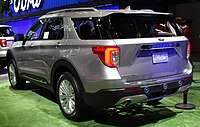 Explorer Hybrid Limited
Explorer Hybrid Limited_at_IAA_2019_IMG_0425.jpg) Explorer Plug-in Hybrid (rear)
Explorer Plug-in Hybrid (rear) Explorer ST
Explorer ST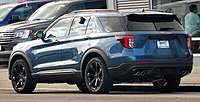 Explorer ST (rear)
Explorer ST (rear)
Variants
Ford Explorer Sport (1991-2003)
As the direct successor of the Bronco II, Ford developed a three-door version of the Explorer for the 1991 model year; while 10 inches shorter than its five-door counterpart, the three-door was still nearly 13 inches longer than the Bronco II. For the first generation, the three-door was available in any trim (except Limited), with Sport offered as a trim exclusive to the three-door. Distinguished by black-colored wheel wells and rocker panels, Sport was slotted between XL and XLT. For 1995, Expedition was offered as an trim package for the three-door Explorer; replacing the Eddie Bauer trim, the nameplate was retired after 1995 in preparation for the 1997 full-size four-door SUV.
During the second generation, the XL and XLT trims were retired for the 1998 model year, with all three-door Explorers becoming Explorer Sports. For 2001, the Explorer Sport was split from the four-door Explorer, retaining the second-generation body and chassis and adopting the front fascia of the Explorer Sport Trac.
Ford discontinued the Ford Explorer Sport following the 2003 model year, with the final vehicle produced in July 2003.
- 1991-1994 Ford Explorer XL
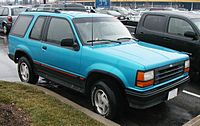 1991-1994 Ford Explorer Sport
1991-1994 Ford Explorer Sport 1995-2000 Ford Explorer Sport
1995-2000 Ford Explorer Sport 2001-2003 Ford Explorer Sport
2001-2003 Ford Explorer Sport
Ford Explorer Sport Trac (2001-2010)
Introduced in 2000 as a 2001 model, the Explorer Sport Trac is a mid-size pickup truck derived from the second-generation Explorer, becoming the first mid-size Ford pickup. In contrast to the Ranger, the Sport Trac was marketed primarily as a personal-use vehicle rather than for work use.
Offered solely as a four-door crew cab, the design of the Sport Trac shared commonality with multiple vehicles. Sharing the frame and wheelbase of the Ranger SuperCab, the Sport Trac combined the front fascia of the Explorer Sport with a crew cab derived from the four-door Explorer; the pickup bed (designed for the model line) shared its tailgate with the F-150 SuperCrew.
The 2001-2005 Sport Trac was the final version of the Explorer derived from the Ranger. After skipping the 2006 model year, a second-generation Sport Trac was produced from 2007 to 2010 (derived from the fourth-generation Explorer).
- 2000-2005 Ford Explorer Sport Trac
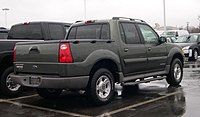 2002 Ford Explorer Sport Trac, rear
2002 Ford Explorer Sport Trac, rear 2007-2010 Ford Explorer Sport Trac
2007-2010 Ford Explorer Sport Trac
Ford Police Interceptor Utility
.jpg)

Following the end of production of the Ford Crown Victoria Police Interceptor in 2011, Ford began development of a police-service variant of the Ford Explorer. For the 2013 model year, Ford introduced the Police Interceptor Utility; as with the related Police Interceptor Sedan variant of the Ford Taurus, the Utility is referred to as a Ford Police Interceptor[72] in lieu of being a Ford Explorer.
As with the Police Interceptor Sedan and the Ford Expedition SSV, the Utility is not sold for retail sale and is specifically designed for use by law enforcement or use by other emergency service agencies. Along with fleet-specific options such as steel wheels and provisions for user-specific paint schemes (such as contrasting doors), the Utility comes with provisions for fitting emergency equipment such as radios, lightbars and sirens. To free up interior space on the center console for equipment, the transmission is fitted with a column-mounted shifter.
The Police Interceptor Utility comes with an all-wheel drive powertrain standard. Over a standard Explorer, the Utility is fitted with larger brake rotors, more advanced ABS and traction control systems, a more efficient cooling system and other standard police equipment.
At its launch, the initial engine fitted was a 305 hp (227 kW) 3.7 L version of the Ti-VCT V6, shared with the Ford Mustang and F-150. For 2014, Ford added the 365 hp (272 kW) 3.5 L EcoBoost V6 (shared with the Police Interceptor Sedan and Ford Taurus SHO).
The California Highway Patrol now uses the Police Interceptor Utility because the current Ford Taurus, Chevrolet Caprice and Dodge Charger patrol cars did not meet the payload the CHP requires for a universal patrol car.[31] In May 2014, statisticians R.L. Polk declared the PI Utility the most popular police vehicle, based on 2013 U.S. sales figures.[73]
2020 Ford Police Interceptor Utility
%2C_front_8.2.20.jpg)
For the 2020 model year, Ford has created a second-generation Police Interceptor Utility, derived from the sixth-generation Explorer.[74] Offered exclusively in an all-wheel drive configuration, the Utility is offered with a twin-turbocharged 3.0L V6 and as a hybrid, with a 3.3L V6 and an electric motor.[74]
Following the shift from the D4 to the CD6 architecture, the Police Interceptor Utility gains cargo space (even with hybrid batteries onboard) over its predecessor.[74] In total, the hybrid system increased the combined fuel economy of the Utility from 19 MPG to 24 MPG,[74] a 26% increase.
Mazda Navajo (1991-1994)
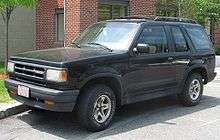
The first-generation Ford Explorer was sold by Mazda from 1991 to 1994 as the Mazda Navajo. Offered solely in a three-door configuration, only minor design details differed the Navajo from its Ford counterpart. Along with significantly reducing the development costs of the model line for Mazda, the assembly of the Navajo by Ford in the United States allowed Mazda to circumvent the chicken tax (in contrast to intended Japanese-brand competitors Nissan Pathfinder and Toyota 4Runner).
Along with a revised front fascia, the Navajo received new taillamps and wheels; the bumpers were painted dark gray (resulting in the deletion of all chrome trim).[75] The interior was largely shared between the two model lines, with the Navajo receiving its own lettering for the instrument panel (in line with other Mazda vehicles); Mazda lettering was added to the Ford steering wheel hub.
In place of the three trims offered on the three-door Ford Explorer, Mazda offered the Navajo in base DX and top-tier LX trim[75] (roughly the equivalent of the Explorer Sport and three-door Explorer XLT). Offered only with four-wheel drive at its launch, a rear-wheel drive version of the Navajo was introduced for 1992. As with the first-generation Explorer, all Navajos were fitted with a 4.0L V6; a five-speed manual was standard, with a four-speed automatic offered as an option (on both the DX and LX[75]).
In the early 1990s, SUVs transitioned into alternatives to station wagons, leading to a decline in demand for two-door SUVs. After the 1994 model year, Mazda withdrew the Navajo, returning in 2000 with the four-door Tribute (a counterpart of the Ford Escape).
Mercury Mountaineer (1997-2010)
The Ford Explorer was sold by the Mercury division as the Mercury Mountaineer from 1997 to 2010. Developed as a competitor for the Oldsmobile Bravada and the 1993 Jeep Grand Wagoneer, the Mountaineer was a four-door premium SUV slotted above the Explorer Limited. Marking the reintroduction of the waterfall grille to the Mercury brand, the model line was distinguished by two-tone (and later monochromatic) styling different from the Explorer.
Coinciding with the 2010 closure of the Mercury brand, the Mountaineer was withdrawn after the 2010 model year; three generations were produced, with the Mountaineer serving as the largest Mercury SUV (above the Mariner).
 1998-2001 Mercury Mountaineer
1998-2001 Mercury Mountaineer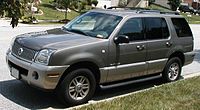 2002-2005 Mercury Mountaineer
2002-2005 Mercury Mountaineer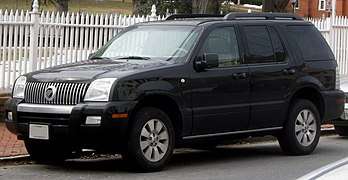 2006-2010 Mercury Mountaineer
2006-2010 Mercury Mountaineer
Lincoln Aviator
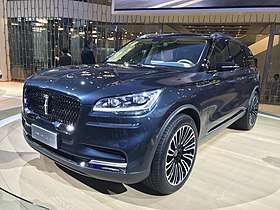
The Ford Explorer has been sold twice by the Lincoln division as the Lincoln Aviator. From 2003 to 2005, the Lincoln Aviator was marketed as a counterpart of the third-generation Explorer. The first mid-size SUV sold by Lincoln, the model line was slotted between the Mercury Mountaineer and the Lincoln Navigator. Following the introduction of the fourth-generation Explorer, the model line was repackaged as a CUV based on the Ford Edge and renamed the Lincoln MKX (today the Lincoln Nautilus).
For 2020, the Lincoln Aviator was revived (after a 14-year hiatus) as a mid-size SUV; as before, the model line is a Lincoln counterpart of the Ford Explorer (now the sixth generation) and the Lincoln Navigator. The second-generation Aviator is the first Lincoln vehicle offered as with plug-in hybrid capability as an option; its 494 hp combined output is the highest-ever for a Lincoln vehicle.
Export sales
UK models
In the UK, the Ford Explorer was initially available as just one model, with the 4.0-litre engine and with a high specification – the only dealer options being leather interior. Second and third-generation Explorers for the UK and other RHD markets utilised a center console-mounted shifter and hand parking brake instead of the steering column-mounted shifter and parking brake pedal used in the North American models. In 1998, a facelifted Explorer was available with minor cosmetic interior changes and a revised rear tail lift which centered the rear number plate. In 1999 the model range was revamped slightly, the base model becoming the XLT and a special edition North Face version marketed with a tie in to North Face outdoor clothing. The North Face version was available in a dark green or a silver, with body-colored bumpers, heated leather seats and a CD multichanger as standard. In 2000, the North Face was also available in black.
Middle East and Asia
In the Middle East, Taiwan, and China, the 2012 Ford Explorer is currently available in several trims, all of which have a 3.5-liter V6 engine and an automatic gearbox. Some GCC markets offer the front-wheel-drive version as a base model, while most of the trims have standard all-wheel-drive.[76] The latest generation Explorer was made available in Japan the Fall of 2015.[77]
Current exports
As of 2009, the Explorer is also sold in Bolivia, Chile, Canada, Mexico, Panama, Dominican Republic, People's Republic of China, Japan, South Korea, Israel, Republic of China (Taiwan), The Philippines, Turkey, Russia, Iceland, Germany, the Middle East, and certain countries in South America and Africa.
As of 2014, the Explorer is also available in Ukraine and Belarus. As of 2018, American-made Explorers are also exported to Vietnam.[78]
Other usage
Gothic black Ford Explorer vehicles are also used by federal agencies, such as the United States Secret Service.
Criticism and controversies
Rollover and Firestone Tire controversy
240 deaths and 3,000 catastrophic injuries resulted from the combination of early generation Explorers and Firestone tires.[17] The tire tread separated and the vehicle had an unusually high rate of rollover crash as a result. Both companies' reputations were tarnished.[79] This event led to a disruption in the 90-year-old Ford/Firestone partnership.
Rollover risk is inherently higher in truck-based vehicles, like the Explorer, than in ordinary passenger cars, as modification for bulky 4-wheel-drive hardware requires increases in height to avoid compromising ground clearance (raising the center of gravity), while a short wheelbase further reduces stability.[17] The previous Bronco II had already been cited by Consumer Reports for rollover tendencies in turns.[17]
The Explorer was cleared by the NHTSA as no more dangerous than any other truck when driven unsafely. It used the same tires as the Ford Ranger with a relatively low rating for high temperatures. Lowering tire pressure recommendations softened the ride further and improved emergency stability through increased traction, but increased the chances of overheating tires.[80] A 1995 redesign with a new suspension slightly raised the Explorer's center of gravity, but it was called inconsequential by a Ford spokesman. Memos by Ford engineers suggested lowering the engine height, but it would have increased the cost of the new design.
Explorer rollover rates, at the time of the controversy, were higher than any of its competitors. While Firestone turned out millions of sub-standard and potentially defective tires, and was the initial cause of loss of control on many Ford Explorer Firestone tire tread separation rollovers, the blame shifted towards Ford for a defectively designed and unstable vehicle .[81]
In May 2000, the US National Highway Traffic Safety Administration (NHTSA) contacted Ford and Firestone about a higher than normal incidence of tire failures on Ford Explorers, Mercury Mountaineers, and Mazda Navajos fitted with Firestone tires (later including Ford Ranger and Mazda B-Series pickup trucks). The failures all involved tread separation, in which the outer tread carcass would delaminate and cause a rapid loss of tire pressure. Ford investigated and found that several models of 15 in (381 mm) Firestone tires (ATX, ATX II, and Wilderness AT) had higher failure rates, especially those made at Firestone's Decatur, Illinois plant.
Ford recommended a tire inflation of only 26 pounds per square inch (179 kPa) likely contributing to the tread separation problem by causing the tires to operate at higher than normal temperatures.[17]
Ford argued that Firestone was at fault, noting that the tires made by Firestone were very defective. Nevertheless, Ford subsequently recommended that front and rear tires should be inflated to 30 pounds per square inch (207 kPa) on all Explorer models and mailed a replacement tire pressure door sticker indicating the same to all registered owners.
Some have argued that poor driver reaction to tire blowout was a contributing factor.[82] When a tire blew, the vehicle would experience a sudden sharp jerk, and many drivers reacted by counter-steering in an attempt to regain control. This action would cause a shift of the vehicle's weight, resulting in a rollover especially at higher speeds (many reports of rollovers were of vehicles being driven at speeds of 70 mph (113 km/h) and above). In a test simulating dozens of tire blowouts, Larry Webster, a test-driver for Car & Driver magazine, was repeatedly able to bring a 1994 Explorer to a stop without incident from speeds of 70 mph (113 km/h).[82][83] According to Forbes magazine, car experts and NHTSA claim that the vast majority of crash accidents and deaths were caused not by the vehicle, but by the driver, by road conditions or some combination of the two.[84] Many vehicle injury attorneys dissent from this view.[85][86]
In response to Firestone's allegations of the Explorer's design defects, NHTSA undertook a preliminary investigation and reported that further action was not required. Its conclusion was that the Explorer was no more prone to rollover than other SUVs given their high center of gravity.[87] The subsequent introduction and proliferation of electronic stability control systems have essentially addressed and mitigated this shortcoming.
In May 2001, Ford announced it would replace 13 million Firestone tires fitted to Explorer vehicles.[17]
U-Haul trailers
On December 22, 2003, U-Haul, the largest American equipment rental company, announced it would prohibit its outlets from renting trailers to persons planning to tow behind Ford Explorers due to liability concerns, with no published data to substantiate the claim.[88] Unofficial reports from employees indicated that it was due to the rear bumper separating from the vehicle, including the tow hook assembly. U-Haul did not alter its policies regarding the renting of trailers to persons planning to tow behind the Mercury Mountaineer, Mazda Navajo or earlier versions of the Lincoln Aviator, which are all mechanically identical to the Ford Explorer.[88] In mid-2013, U-Haul began allowing Ford Explorers of model year 2011 and newer to tow their trailers. All other Ford Motor Company vehicles are allowed to tow U-Haul trailers.[89]
Reliability
The 4.0L SOHC V6 engine found on second, third, and fourth generation Explorers was notorious for the plastic OEM timing chain guides, cassettes, and tensioners breaking resulting in timing chain ticking, rattle or "death rattle". This problem can occur as early as 45,000 mi (72,000 km) in some vehicles. When the engine is run for an extended period of time with this issue, the engine can jump timing or cease from running, damaging the heads and valves.
Timing chain rattle was mitigated in later years of the SOHC (in most vehicles, after 2002) with updated cassettes and tensioners.[90]
The 5R55 series transmissions found on second through fourth generation Explorers was also notorious for premature failures. Common issues with this transmission include but are not limited to servo pin bore wear, premature transmission case wear, and excessive valve body wear.[91]
Sales
| Calendar year | Explorer (US) | Police Interceptor Utility (US) |
|---|---|---|
| 1990 | 140,509[92] | N/A |
| 1991 | 282,837 | |
| 1992 | 292,069 | |
| 1993 | 301,668 | |
| 1994 | 278,065 | |
| 1995 | 395,227 | |
| 1996 | 402,663 | |
| 1997 | 383,852[93] | |
| 1998 | 431,488 | |
| 1999[94] | 428,772 | |
| 2000 | 445,157 | |
| 2001[95] | 415,921 | |
| 2002[96] | 433,847 | |
| 2003 | 373,118 | |
| 2004[97] | 339,333 | |
| 2005 | 239,788 | |
| 2006[98] | 179,229 | |
| 2007 | 137,817 | |
| 2008[99] | 78,439 | |
| 2009[100] | 52,190 | |
| 2010[101] | 60,687 | |
| 2011[102] | 135,179 | |
| 2012[103] | 158,344 | 5,863 |
| 2013[104] | 178,311 | 14,086 |
| 2014[105] | 189,339 | 20,655 |
| 2015[106] | 224,309 | 24,942 |
| 2016[107] | 216,294 | 32,213 |
| 2017[108] | 238,056 | 33,075 |
| 2018[109] | 227,732 | 33,839 |
| 2019[110] | 168,309 | 18,752 |
| Total | 7,612,255 | 151,212 |
See also
References
- https://www.edmunds.com/ford/explorer/1991/review/
- "2020 Ford Explorer SUV Prices, Reviews, and Pictures". Edmunds.
- "2019 Ford Explorer SUV Pricing, Features, Ratings and Reviews". Edmunds.
- "2020 Ford Explorer: What to Expect from Ford's Redesigned Family Hauler". August 2018.
- J. “Kelly” Flory, Jr. (October 31, 2019). American Light Trucks and Utility Vehicles, 1967-1989: Every Model, Year by Year. McFarland. p. 1359. ISBN 978-1-4766-2652-9.
- "Documents Show Ford's Concerns Over Explorer". latimes. August 24, 2000.
- "Ford Explorer Rollover History Tire Recall Chronology". Willis Law Firm. Archived from the original on September 19, 2015. Retrieved September 17, 2015.
- Carrillo III, Manuel (January 10, 2019). "6 generations of Ford Explorers: A history of the groundbreaking SUV". CNET. Retrieved August 4, 2020.
- Snow Country. October 1990. p. 84. ISSN 0896-758X.
- "Past Truck of the Year Winners". Motor Trend.
- "SPORT-UTILITY VEHICLES : Enduring style or 'flash in pan'?". Nl.newsbank.com. Retrieved March 27, 2017.
- "Right Hand Drive JDM Imports – RightDrive – Est. 2007". Right Drive. Archived from the original on November 4, 2013.
- "1995 Explorer first production vehicle to use a neon stop lamp". Retrieved May 21, 2012.
- Truby, Mark (August 4, 2000). "Ford Refines 2002 Explorer". Explorer Forum. The Detroit News.
- "Ford Explorer project leader aimed at a global standard". Automotive News. March 26, 2001.
- Bradsher, Keith (April 26, 2001). "Explorer Model Raises Doubts About Safety". New York Times.
- "Ford Explorer-Firestone Tire". autosafety.org.
- "Ford to build new Escape in Kentucky, adding 1,800 jobs". Automotive News. December 9, 2010.
- "2008 Ford Explorer Review". Edmunds.com. Retrieved October 7, 2010.
- "2009 Ford Explorer Review and Specs". Edmunds.com. Retrieved October 7, 2010.
- "Death Row: Ford Pulls Plug on GT Supercar, Lincoln LS and Explorer Sport Trac Adrenalin". Edmunds Inside Line. February 6, 2006. Archived from the original on June 24, 2009. Retrieved October 15, 2009.
- ""Tags: 2010 Explorer" – 6 January 2008". Autospies.com. January 5, 2008. Retrieved October 7, 2010.
- Neff, John (October 23, 2008). ""Spy Shots: Next Gen Unibody Ford Explorer Mules Caught" from Autoblog (October 23, 2008)". Autoblog. Retrieved October 7, 2010.
- "Ford to reveal new fuel-saving concept in Detroit". Media.Ford.com. January 6, 2008. Archived from the original on October 5, 2012.
- "Ford to equip half a million vehicles with EcoBoost engine technology for up to 20% better fuel economy". Media.Ford.com. January 6, 2008. Archived from the original on July 28, 2013.
- "Ford's Chicago plant gets a $1 billion upgrade". Detroit News.
- Pete, Joseph S. "Chicago Assembly Plant will shut down for entire month of March as it switches to new Explorer model". nwitimes.com.
- "Ford Sollers Joint Venture Starts Work Today in Russia; Announces Ford Explorer SUV to be Built in Tatarstan". media.ford.com. Archived from the original on December 8, 2012. Retrieved January 12, 2012.
- Nick Bunkley. "Why Ford's Blue Oval is missing from the 2016 Explorer". Automotive News.
- Wert, Ray. "2011 Ford Explorer: This Is Not An SUV".
- Scott Evans (May 25, 2012). "Ford Police Interceptor Utility is California Highway Patrol's Next Cruiser". Motor Trend. Retrieved March 27, 2017.
- "2016 Ford Explorer SUV - Specifications- Ford.com". ford.com. Archived from the original on February 9, 2016.
- "2011 Ford Explorer, View Exterior Specifications". FordVehicles.com. Archived from the original on January 10, 2013. Retrieved October 7, 2010.
- Quiroga, Tony (May 2009). "2011 Ford Explorer – Car News". Car & Driver. Archived from the original on May 11, 2009.
- Shunk, Chris (March 31, 2009). "2011 Ford Explorer reportedly to be built in Chicago on Taurus X platform". Autoblog.
- "2021 Ford® Bronco SUV | The Legend Returns by Popular Demand". Retrieved July 10, 2020.
- "Jim Holland: Bringing Luxury Levels Of Content, Craftsmanship To Reinvigorated Ford Explorer, Ford Motor Company Newsroom". Media.ford.com. Archived from the original on May 24, 2010. Retrieved October 7, 2010.
- from Yahoo.com (July 21, 2010).
- "All-new 2011 Ford Explorer Begins Production in Chicago - Auto News". Truck Trend. December 2, 2010.
- "FORD TO BRING NEXT-GENERATION FORD EXPLORER, 1,200 JOBS TO CHICAGO MANUFACTURING FACILITIES" (Press release). Ford Motor Company. January 26, 2010. Archived from the original on July 28, 2013.
- "Report: Ford Explorer orders nearly double expectations". Autoblog. November 28, 2010. Retrieved November 28, 2010.
- "Ford – Cars, SUVs, Trucks & Crossovers, Ford Vehicles, The Official Site of Ford Vehicles". FordVehicles.com. Archived from the original on September 30, 2010. Retrieved October 7, 2010.
- "Ford – Cars, SUVs, Trucks & Crossovers, Ford Vehicles, The Official Site of Ford Vehicles". FordVehicles.com. Archived from the original on September 30, 2010. Retrieved October 7, 2010.
- "2011 Ford Explorer, View Full Engine Specifications". FordVehicles.com. Archived from the original on September 30, 2010. Retrieved October 7, 2010.
- "The Pioneering SUV Isn't One Anymore". The Wall Street Journal. Retrieved September 20, 2012.
- "Road test: 2011 Ford Explorer". canada.com. Retrieved September 20, 2012.
- "2011 Ford Explorer Powertrain". Motor Trend. Retrieved January 4, 2011.
- Abuelsamid, Sam (July 26, 2010). "2011 Ford Explorer puts four-cylinder EcoBoost engine above V6 in pecking order – Autoblog". Autoblog.com. Retrieved October 7, 2010.
- "Ford – Cars, SUVs, Trucks & Crossovers, Ford Vehicles, The Official Site of Ford Vehicles". FordVehicles.com. Archived from the original on September 30, 2010. Retrieved October 7, 2010.
- "2012 Ford Explorer". thecarconnection.com. Retrieved September 20, 2012.
- "Ford – Cars, SUVs, Trucks & Crossovers, Ford Vehicles, The Official Site of Ford Vehicles". FordVehicles.com. Archived from the original on September 30, 2010. Retrieved October 7, 2010.
- "2011 Ford Explorer Revealed – Kelley Blue Book". Kbb.com. July 26, 2010. Retrieved January 4, 2011.
- "Ford – Cars, SUVs, Trucks & Crossovers, Ford Vehicles, The Official Site of Ford Vehicles". FordVehicles.com. Archived from the original on September 30, 2010. Retrieved October 7, 2010.
- "2010 Ford Explorer, View Towing Specifications". FordVehicles.com. Archived from the original on January 17, 2010. Retrieved October 7, 2010.
- "2011 Ford Explorer Will Offer Inflatable Seatbelts to Rear Seat Passengers – Automotive News & Car Rumors at Automobile Magazine". Rumors.automobilemag.com. November 5, 2009. Archived from the original on May 19, 2010. Retrieved October 7, 2010.
- Chris Isidore (June 12, 2019). "Ford recalling 1.2 million Explorers over suspension issue". CNN. Retrieved June 16, 2019.
- "2011 & Newer – Search Results: Ford Explorer – Safercar – National Highway Traffic Safety Administration (NHTSA)". safercar.gov. Archived from the original on January 6, 2016.
- "Ford Explorer". iihs.org.
- "New 2011 Ford Explorer: North American Truck of the Year". Media.ford.com. February 3, 2011. Archived from the original on February 8, 2011. Retrieved April 19, 2011.
- "Ford's Rear Inflatable Seat Belt Wins '2011 Best New Technology' Award". Ford Motor Company. Retrieved May 23, 2011.
- "New Ford Explorer Sport: Fuel-Efficient, High-Performance SUV Features Inspired Design Cues, EcoBoost V6 Engine". media.ford.com. March 28, 2012. Archived from the original on March 29, 2012. Retrieved March 28, 2012.
- "2013 Ford Explorer Sport presages running changes for entire range" from Autoblog (March 28, 2012)
- "2013 Chevy Traverse debuts with new face, minor tweaks" from Autoblog (March 28, 2012)
- "2017 Ford Explorer SUV | Features Designed for Comfort and Style". Ford.com. Retrieved April 18, 2017.
- Lorio, Joe (January 9, 2019). "The 2020 Ford Explorer Undergoes Its Biggest Changes in a Decade". Car and Driver. Retrieved January 9, 2019.
- "Ford=Lincoln Trucks (Build out Final order Star up dates)". Donlen. March 4, 2019. Retrieved March 5, 2019.
- Duff, Mike (April 2, 2019). "The Ford Explorer Plug-In Hybrid Makes More Power than the Explorer ST". Car and Driver. Retrieved April 2, 2019.
- CAPPARELLA, Joey (December 21, 2018). "The New 2020 Ford Explorer Officially Debuts January 9". Car and Driver. Retrieved December 21, 2018.
- Riisenberg, Tarmo (April 4, 2019). "Ford Explorer will make it to Europe only as a hybrid". Autoleht. Retrieved April 4, 2019.
- https://www.latimes.com/business/story/2019-10-22/ford-botches-launch-of-explorer-suv-putting-its-ceo-back-in-the-hot-seat
- https://www.iihs.org/ratings/vehicle/ford/explorer-4-door-suv/2020
- "Ford Motor Company Official Global Corporate Homepage | Ford.com". Corporate.ford.com. March 13, 2017. Retrieved March 27, 2017.
- "Auto news - Detroit Free Press - freep.com". Detroit Free Press.
- "This Is the New 2020 Ford Explorer—in Cop-Car Form". Car and Driver.
- "Rare anywhere: Mazda Navajo". Autoweek. March 15, 2018. Retrieved February 1, 2020.
- "Ford Explorer 2011-2012 full GCC spec-sheets". Drive Arabia.
- "Ford Japan". ford.co.jp. Archived from the original on October 1, 2015.
- "Ford Explorer". Ford.com.vn. Retrieved May 4, 2019.
- "Public Citizen Auto Safety". citizen.org.
- Mac Demere. "Why Blowouts Happen—and How to Avoid Them". Popular Mechanics.
- Pat McCarty (July 17, 2001). "Ford Explorer Rollover". Ford Explorer Rollover. Retrieved March 27, 2017.
- "Bad Drivers, Good Credibility – car makers face uphill struggle against public perception", Ward's Auto World, April 2001
- Doron Levin column, Detroit Free Press, October 27, 2000
- Dan Ackman, "Ford, Firestone Face Off", Forbes, June 19, 2001
- "Tire Separation Causes California Auto Accident Involving Police Officer". Panish, Shea & Boyle LLP. Panish, Shea & Boyle. August 31, 2010.
- "Microsoft Word - Tire Tread Separation - 2 Theories of Liability.doc" (PDF). Cdrb-law.com. Archived from the original (PDF) on March 28, 2016. Retrieved March 27, 2017.
- "NHTSA Denies Firestone Request For Ford Explorer Investigation". U.S. Department of Transportation News. Archived from the original on June 13, 2002.
- Mayne, Eric (January 14, 2004). "U-Haul rejects Explorers". USA Today. Retrieved May 2, 2010.
- "Frequently asked questions: Truck rentals". U-Haul. Retrieved October 7, 2010.
- Carley, Larry (April 15, 2013). "'Exploring' Service Needs On The Ford 4.0L V6 Engine". Underhood Service. Retrieved July 21, 2019.
- "Ford "Four Versions of 5R55"". The Transmission Shop. Retrieved July 21, 2019.
- "Ford Explorer Retrospective – Automobile Magazine". Automobile. July 23, 2010.
- "Pickups and sport utility sales continue to climb in the United States". archive.is. June 15, 2013. Archived from the original on June 15, 2013.
- "Ford Motor Company Sets New Full Year U.S. Sales Record". Theautochannel.com. Retrieved October 7, 2010.
- "Ford Motor Company's December U.S. Sales Climb 8.2 Percent" (PDF). Ford Motor Company. Archived from the original (PDF) on April 30, 2011.
- "Ford's F-Series Truck Caps 22nd Year in a Row as America's Best-Selling Vehicle With a December Sales Record". Theautochannel.com. September 13, 2010. Retrieved October 7, 2010.
- "Ford Achieves First Car Sales Increase Since 1999". Theautochannel.com. September 13, 2010. Retrieved October 7, 2010.
- "CROSSOVERS, LINCOLN HIGHLIGHT FORD'S 2007 SALES PERFORMANCE; FURTHER GROWTH EXPECTED IN 2008" (PDF). media.ford.com. January 3, 2008. Archived from the original (PDF) on May 25, 2011. Retrieved March 27, 2017.
- "F-SERIES DRIVES FORD TO HIGHER MARKET SHARE FOR THIRD CONSECUTIVE MONTH" (PDF). media.ford.com. January 5, 2009. Archived from the original (PDF) on February 6, 2009. Retrieved January 4, 2011.
- "FORD CAPS 2009 WITH 33 PERCENT SALES INCREASE, FIRST FULL-YEAR MARKET SHARE GAIN SINCE 1995" (PDF). media.ford.com. January 5, 2010. Archived from the original (PDF) on July 11, 2011. Retrieved January 5, 2010.
- "FORD'S 2010 SALES UP 19 PERCENT – LARGEST INCREASE OF ANY FULL-LINE AUTOMAKER; FOUNDATION SET FOR GROWTH IN 2011 | Ford Motor Company Newsroom". Media.ford.com. January 4, 2011. Archived from the original on September 2, 2011. Retrieved January 6, 2012.
- "2011 Ford Brand Sales up 17 Percent for the Year in U.S.; Fuel-Efficient Cars, Utilities, Trucks Drive Sales Gains" (PDF). media.ford.com. January 4, 2012. Archived from the original (PDF) on January 31, 2012. Retrieved January 4, 2012.
- "Ford Cars, Utilities and Trucks All Post U.S. Sales Gains in 2012; Company Posts Best December Sales Since 2006". media.ford.com. January 3, 2013. Archived from the original on January 6, 2013. Retrieved January 3, 2013.
- "Ford Motor Company Delivers Best Sales Year Since 2006 ; Ford Is Top Brand with Records for Fiesta, Fusion, Escape" (PDF). Media.ford.com. Archived from the original (PDF) on December 26, 2014. Retrieved March 27, 2017.
- "Ford Posts Best U.S. December Sales Results since 2005 ; Ford Once Again Best-Selling Brand and Best-Selling Vehicle" (PDF). Media.ford.com. Retrieved March 27, 2017.
- "New Products Make Ford America's Best-Selling Brand for Sixth Straight Year; F-Series No. 1 Vehicle for 34 th Year" (PDF). Media.ford.com. Retrieved March 27, 2017.
- Luft, Alex (January 4, 2017). "Ford Motor Company December 2016 Sales Numbers USA". Fordauthority.com. Retrieved March 27, 2017.
- "Ford SUVs Post Record Sales While F-Series Marks 41 Years as America's Best-Selling Pickup; Ford Achieves 8th Consecutive Year as the Country's Favorite Brand" (PDF). Media.ford.com. Retrieved January 3, 2018.
- https://media.ford.com/content/dam/fordmedia/North%20America/US/2019/01/03/sales-dec-18.pdf
- https://media.ford.com/content/dam/fordmedia/North%20America/US/2020/01/06/sales-4q2019.pdf
External links
| Wikimedia Commons has media related to Ford Explorer. |
- Ford Explorer official website
- Ford Explorer America Concept SUV at Ford Auto Shows
- Ford Explorer America Concept SUV On Ford and the Environment SMPR
- History of the 1st Ford Explorer
- Serious Explorations – Ford Explorer Enthusiast Website
- Vehicle Specs for the Ford Explorer models and variants from Where Can I Buy A Car Online